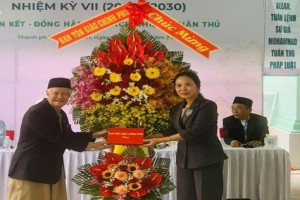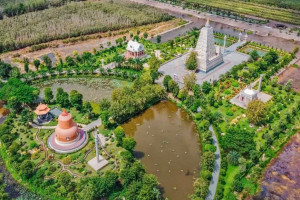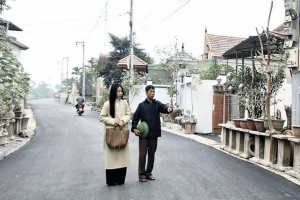
But Thap temple, also called Ninh Phuc temple (its old name was Nhan Phap). It is located near the dyke of Duong river in Dinh To commune, Thuan Thanh district, Bac Ninh Province. It is about 25km from Hanoi
According to the old writing, Ninh Phuc temple was built in the Tran dynasty (in the 13th century) when Huyen Quang monk lived there. In the early 13th century Zhus Zhus monk (or called Chuyet Tong) managed this temple, he reconstructed temple according to model of Chinese temple style. He also built Bao Nghiem tower. Minh Hanh Tai Tai monk was a disciple of Zhus Zhus. He continued to expand and build temple in 1647.
In 1876, Tu Duc king renamed Nhan Thap village as Bút Tháp village and Bảo Nghiêm tower as Tháp Bút tower.
The cluster of buildings lies on an axis more than 150m and consists of 9 buildings: three-door entrance, the bell tower, the front hall, the incense- burning hall, the upper sanctuary, Tích Thiên cell ( Practice Charity cell), guest house, the sanctuary and rear hall
The three-door entrance has 3 compartments. The central compartment is larger than the two ones. These compartments are separated by wood and brick pillars.
Entering by three- door entrance visitors pass a small road with 4 m in width and 24 m in length, to reach bell tower. The bell tower consists of rectangular shapes, each of one is about 8.65 m in length and 8.20 m in width. This bell tower has two stories and 8 roofs. .
The visitors come to the front hall where stand two giant Guardian spirits. They were made of earth and covered with paint. On the left of the front hall there are statues of goers-servant and Saint- monk. The front hall has 7 compartments, 32 pillars. In the central compartment there is a horizontal lacquered board with words "Ninh Phúc thiền tự" ( Ninh Phuc temple) and "Dương Hòa Bát niên, tuế thứ Nhâm Ngọ niên, trọng Hạ cốc đán"(good day in May, 1642)
At the end of the front hall there are two stone steles. The stone stele on the right is about 2.3 m in height and 1.1 m in length, stele’s edging is carved with dragon and cloud. On stele there is a word “Phật” (Buddha). On the front side of the stele has words “Sắc Ninh Phúc thiền tự bi ký” (Inscription for the stele of Ninh Phuc temple). On the back side of stele there are words “Ninh phúc thiền tự tam bảo té tự điền bi” This stele was erected in the 5th year of Phuc Thai era (1647).The text was written by monk Minh Hanh Tai Tai. The stone stele on the left is 1.6 m in height and 1 m in width. The stele’s edging is carved with dragon and clouds. On the front side of stele has the words "Ninh Phúc thiền tự tam bảo tế tự điền bi." The inscription was carved in a good day of November in 1674. The back side was decorated as the front side. This inscription was carved in a good day of the Lotus month in the 5th year of Phuc Thai era (1647). Both stone steles were built on the back of the large stone turtles.
A building links the front hall to the upper sanctuary. In the upper sanctuary there is a board with the words “chiêm vọng từ bi ". On the right of the upper sanctuary there are bas–reliefs carved with dragons and phoenix and board with the words "Đế đạo long xương"; on the left there are bas- reliefs carved with dragons and phoenix and a board with the words "Hoàng đồ củng cố." At the end of the upper sanctuary there is a horizontal lacquered board entitled “Đại hùng bảo điện" . It was built on "Dương Hòa bát niên tuế thứ Nhâm Ngọ, mạnh đông cốc đán trùng tu" (good day in October 1642)
The upper sanctuary lies on a foundation more than 1m high .It is 19m in length and 10.6 m in width. It has 4 compartments and 24 iron wood pillars. Its stole was carved with lotus. It is surrounded by a stone parapet wall with 26 bas- reliefs; each one is about 1.2 m in length, 0.6 m in height and 0.14 m in width. It was carved with many themes about life in the rural delta in the North of Vietnam.
Inside the upper sanctuary there are statutes of Buddha Bodhisattva and Arhats. Concretely, in the central compartment, there are statues of Buddha, Bodhisattvas and Trinity of Buddhas; in two compartments on the right there are there are statutes of one thousand eye and one thousand arm Avalokitesvara, Manjushri, Bodhisattva, nine Arhats, Quan Am Thi Kinh; in two compartments on the left there are statues of Sakyamuni, Majusri, Bodhisattva, nine Arhats , Y Lan Queen.
From the upper sanctuary, visitors can get a building called Tich Thien Am (Practise Charity Cell), over a curved three –span stone bridge. This bridge is 4.1 m in length. On the bridge there are 12 stone bas –reliefs of birds, flowers and leaves. The bridge is crossing the pond of lotus
Tich Thien cell is an original architectural work. This cell has a three- layer roof. In the cell, there is wooden octahedral tower of 9 stories, turntable on a axis, with Buddha statue and 32 bas- relifes . In right compartment of this cell there is a statute of Buddha Amitabha statue and a stele with the words "Tích thiện am” (Practise Charity Cell) .This stele was erected in "Chính hòa thập nhị niên tuế thứ Tân Mùi, thập nhất nguyệt, cốc nhật lương thời thủy tạo" (in good time of a good day November 1691). The left compartment of the cell there is Buddha Amitabha statue.
Behind Thien Am cell there are three parallel buildings: guest houses, sanctuary and the real hall. The guest house has 5 compartments. On the wall of the guest house there is a board with the words "This house was restored by the help of Ministry of Foreign Affairs of the Federal Republic of Germany in 1990 - 1998".
Passing a yard, visitors will see the sanctuary. This sanctuary has 5 compartments. It is 16.5 meters in length and 9 m in width. In the central compartment, there is an altar of Trinh Thi Ngoc Truc queen. In right compartment there is an altar of Le Thi Ngoc Duyen princess. The last compartment on the right, there is stele with the words "Khánh lưu bi kí" 1.6 m high and 0.70 m wide; the stele’s edging was carved dragon, flower and leaf. It was built in the year of Vinh Thinh era 1714. The back side of stele is carved "Ninh Phúc thiền tự bi ký”. Near two walls, there are 10 statues of kings of hell. In the left compartment, there is an altar of Trinh Thi Ngoc Co. In the last compartment, there is an altar of Le Dinh Tu prince
The house of patriarchs has 13 compartments. This house is 26.5 meters in length and 7.7 meters in width. In the central compartment, there are statutes of patriarchs and the horizontal lacquered board with the words "Tổ ấn trùng quang".
In the two compartments on the right, there are six statues and a photo of patriarch In two compartments on the left, there is altar of the 5 Gods of soil, 3 mother goddesses and 4 kings.
Apart from above buildings, Bút Tháp temple also has notable architectural works
Two colonnades, each with 26 compartments, each of compartment is 2.6 m in length and 4 m in width (they were built in the 1990 - 1998)
Outside the left colonnade lies the house of the first generation patriarch, most venerable Chuyet Cong. This house has 5 compartments with 13 m in length and 6.8 meters in width.. In the compartments on the right there are altars of three patriarchs and one stele 2 m high and 1 m in width. the stele’s edging was carved dragon and clouds, the front side of the stele was carved the words "Hiển thụy am- Báo nghiêm tháp bi ký". The back side of the stele was carved with the words "Hiến thụy am hương hỏa điền bi ký". The stele was built in the 5th year of Phuc Thai era (1647), by monk Minh Hanh Tai Tai. In two compartments on the left there are altar of patriarchs
Building behind the left colonnade has altar of Ksitigarbha and horizontal lacquered board.
Bút Tháp temple has many beautiful towers. The most beautiful towers are the five storey Bao Nghiem and the five –storey Ton Duc towers. Bao Nghiem tower is more than 13m high. It was made of stone. In side it, stands the statue of Chuyet Cong; outside, there are 13 various bas- reliefs. In Ton Duc tower there are many books. The books were made from the eighteenth century related to Queen Trinh Thi Ngoc Truc.
On the valued wood sculpture, we should mention in the statue of multi –eye and multi- army Avalokitesvara. This statue was carved by a sculptor Truong in the Le reign. The statue is 3.7 m high. The pedestal of the statue is square which was carved with lotus and animal designs.
Most of the statues, bas- reliefs and altars in Bút Tháp temple were the works of art in the 17th and 18th century.
Bút Tháp temple has been recognized as the Architectural monuments of art by Decision No. 313/VH-BT dated April 28th , 1962 of Ministry of Culture. It is one of the typical temple in Vietnam. This temple has preserved many precious objects in the Le dynasty.
Nguyen Quang Khai




